Rajasthan Board RBSE Class 11 Maths Chapter 8 Sequence, Progression, and Series Ex 8.2
Question 1.
Find the sum of the following progression :
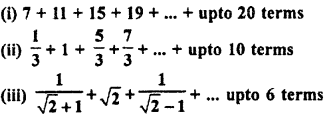
Solution:
(i) Given progression
7 + 11 + 15 + 19 + …
Here, a = 7, d = 11 – 7 = 4, n = 20
Then Sn = \(\frac { n }{ 2 }\)
S20 = \(\frac { 20 }{ 2 }\)
= 10 [14 + 19 × 4]
= 10 × (14 + 76)
= 10 × 90 = 900
Hence, sum of 20 terms is 900.
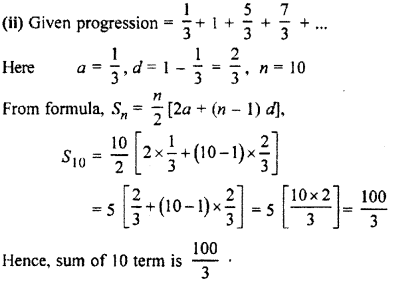
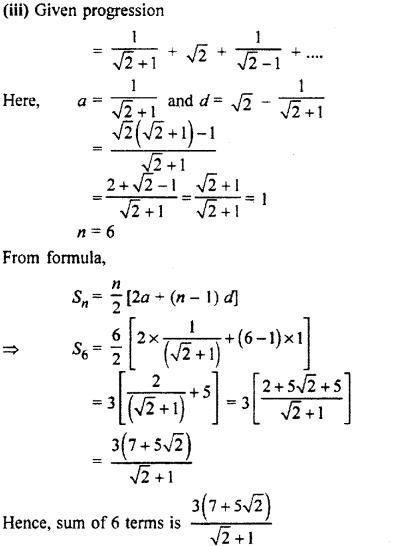
Question 2.
Find the sum of odd integers from 1 to 101, which is divisible by 3.
Solution:
Odd integers from 1 to 101 are
1, 3, 5, 7, 9, …, 101
Integers which are divisible by 3 are
3, 9, 15, 21 99
First term of this series a = 3,
common difference d = 9 – 3 = 6, last term = 99 and let number at last term is n, then last term
= 3 + (n – 1) × 6 = 99
[From formula, l = a + (n + 1 )d]
⇒ 6 (n – 1) = 99 – 3
⇒ (n – 1) = \(\frac { 96 }{ 3 }\)
=16 6
⇒ n = 16 + 1 = 17
Hence, sum of 17 terms,

= 17 × 51 = 867
Hence, sum of odd integers from 1 to 101, which is divisible by 3 is 867.
Question 3.
Find the sum of n terms of A.P. whose rth term is 2r + 3.
Solution:
Given,Tr = 2r + 3
Then Tn = (2n + 3)
Hence, T1 =2 × 1 +3 = 2 + 3 = 5
and T2 = 2 × 2 + 3 = 4 + 3 =7
Common difference
d = T2 – T1 = 7 – 5 = 2
∴ Sum of n terms,
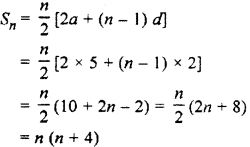
Hence, sum of n terms is n (n + 4).
Question 4.
Sum of n terms of any A.P. is n2 + 2n. Find the first term and common difference.
Solution:
Sum of terms
Sn= n2 + 2n
and S, (n – 1)2 + 2(n-1)
We know that nth term of A.P.
Tn= Sn – Sn – 1
⇒ Tn= (n2 + 2n) – [(n – 1)2 + 2(n − 1)]
= [n2 + 2n] – [n2 + 1 – 2n + 2n – 2]
= [n2 + 2n] – [n2 – 1]
= n2 + 2n – n2 + 1
= 2n + 1
First term T1= 2 × 1 + 1 = 2 + 1 = 3
Second term, T2 = 2 2 + 1 = 4 + 1 = 5
Common difference d = T2 – T1 = 5 – 3 = 2
Hence, first term is 3 and common difference is 2.
Question 5.
If sum of n terms of A.P. 1, 6, 11,…. is 148, then find number of terms and last term.
Solution:
Given progression = 1, 6, 11, …
Sn = 148, a = 1,d = 6 – 1 = 5
∵ Sn = \(\frac { n }{ 2 }\) [2a + (n – 1)d]
⇒ \(\frac { n }{ 2 }\) [2 × 1 + (n – 1) × 5] = 148
⇒ \(\frac { n }{ 2 }\) [2 + 5n – 5] = 148
⇒ n (5n – 3) = 296
⇒ 5n2 – 3n – 296 = 0
On solving,
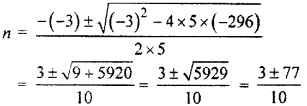
Taking ‘+’, n = 8
Taking ‘-‘, n = –\(\frac { 37 }{ 5 }\)
Negative value of n is impossible.
Hence, n = 8
Last term= T9 = a + 7d
= 1 +7 × 5 = 1 + 35 = 36
Hence, number of terms is 8 and last term is 36.
Question 6.
If in an A.P„ sum of p terms is equal to sum of q terms, then find the sum of (p + q) terms.
Solution:
Let a1 is the first term and d is the common difference of A.P.
Then, sum of first p terms
![]()
and sum of first q terms
![]()
According to question,
some of first p terms = sum of first q terms
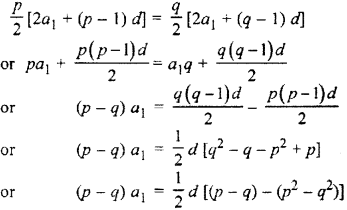
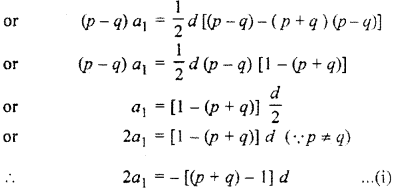
Now, sum of (p + q) terms of this progression
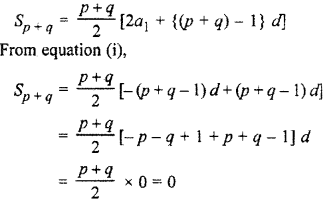
Hence, sum of (p + q) terms of given A.P. is zero.
Question 7.
If sum of n, 2n, 3n terms of any A.P. are S1, S2 and S3 respectively, then prove that S3 = 3 (S2 – S1).
Solution:
Let a is first term and dis common difference of an A.P. then

Subtracting equation (i) from equation (ii)
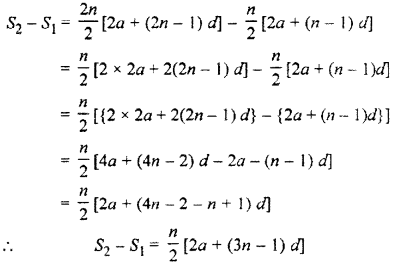
Multiplying by 3 in both sides
![]()
= S3 [From equation (iii)]
Hence, 3 (S2 – S1) = S3
Hence Proved.
Question 8.
If sum of m A.P. of n terms are S1, S2 and S3…, Sm respectively. Their first term are 1, 2, 3,…., m respectively and common difference 1, 3, 5,…., (2m – 1) respectively, then prove that
S1 + S2 + S3 + … + Sm= \(\frac { mn }{ 2 }\) (mn + 1)
Solution:
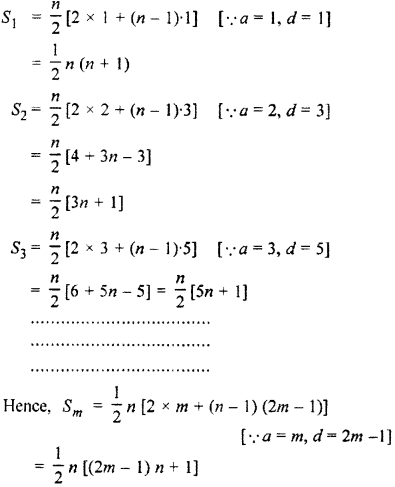
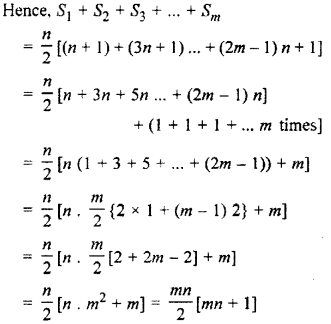
Question 9.
If sum of first p, q, r terms of any A.P. are a, b, c respectively, then prove that :
![]()
Solution:
Let a is the first term and d is the common difference of the given A.P. Then according to question,
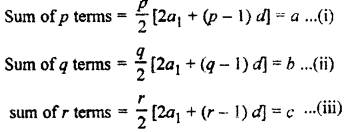
From equation (i),(ii) and (iii)
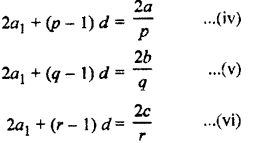
Now, multiplying equation (iv), (v) and (vi) by (q – r), (r – p) and (p – q) respectively.
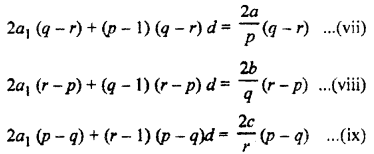
Adding equations (vii), (viii) and (ix),
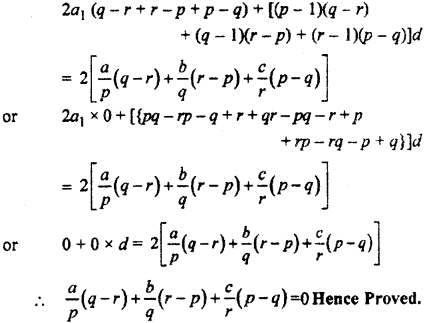
Question 10.
Find three numbers in A.P., whose sum is 12 and sum of their cube is 408.
Solution:
Let three numbers are a – d, a and a + d
Then (a – d) + (a) + (a + d) = 12
⇒ 3a = 12 or a = 4
According to question,
(a – d)3 + a3 + (a + d)3 = 408
⇒ (4 – d)3 + (43) + (4 + d)3 = 408
⇒ (43 – 3(42)d + 3 × 4 × d2 – d3) + (43)
+ (43 + 3(42)d + 3 × 4 × d2 + d3) = 408
⇒ 3(43) + 24d2 = 408
⇒ 24d2 = 408 – 192 = 216
⇒ d2 = \(\frac { 216 }{ 24 }\)
⇒ d2 = 9
⇒ d = 3
Question 11.
If n arithmetic mean are inserted in between 1 and 51 such that ratio of 4th and 7th arithmetic mean is 3 : 5 dthen find the value of n.
Solution:
Let n arithmetic mean between 1 and 51 then
1, A1 + A2 + A3 + …, An 51
(n + 2)th term = 51=1
Then 51 = 1 + (n + 2 – 1)d
[From formula l = a + (n – 1)d]
⇒ (1 + n)d = 51 – 1 = 50
⇒ (n + 1)d = 50
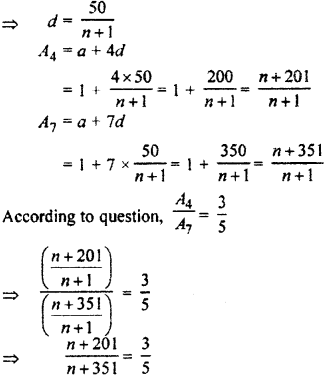
⇒ 5n + 5 × 201 = 3n + 3 × 351
⇒ 5n – 3n = 1053 – 1005
⇒ 2n = 48
⇒ n = 24
Hence, n = 24
Question 12.
If x, y, z are in A.P., then prove that :
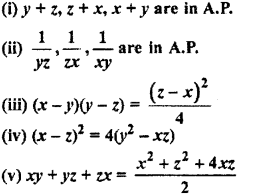
Solution:
(i) y + z, z + x, x + y will be in A.P. if
⇒ (z + x) – (y + z) = (x + y) – (z + x)
⇒ z + x – y – z = x + y – z – x
⇒ z + x = y – z
⇒ z + x = 2y
⇒ y = \(\frac { x + z }{ 2 }\)
Hence, x, y, z are in A.P., which are given.
Hence, y + z, z + x, x + y are in A.P.
Hence Proved.
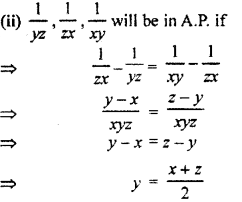
Hence, x,y,z are in A.P., which are given.
![]()
Hence Proved.
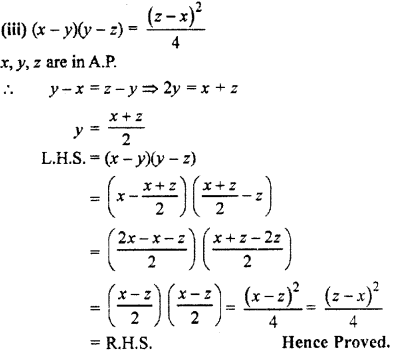
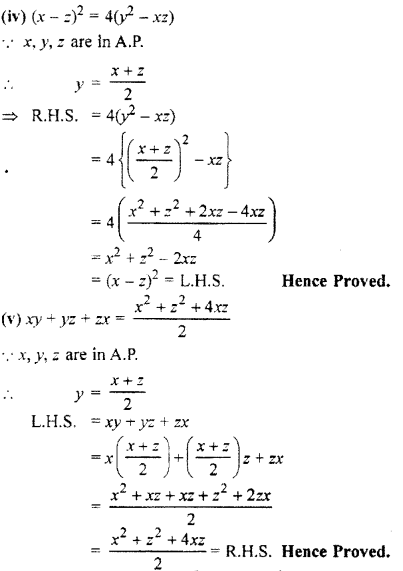
Question 13.
If x2 (y + z), y2 (z + x), z2(x + y) are in A.P., then prove that either x, y, z are in A.P. or xy + yz + zx = 0.
Solution:
∵ x2(y + z), y2(z + x), z2(x + y) are in A.P.
∴ Adding xyz in each terms x2(y + z) + xyz, y2(z + x) + xyz, z2(x + y) + xyz also will be in A.P.
or x(xy + yz + zx), y(xy +yz + zx), z(xy + yz + zx) also will be in A.P.
∴ 2y(xy + yz + zx) = x(xy + yz + zx) + z(xy + yz + zx)
⇒ 2y(xy + yz + zx) = (xy + yz + zx) (x + z)
⇒ 2y(xy + yz + zx) – (xy + yz + zx) (x + z) = 0
⇒ (xy + yz + zx) (2y – x – z) = 0
If 2y – x – z = 0
Then 2y = x + z
⇒ x, y, z are in A.P.
or xy + yz + zx = 0
Hence Proved.
Question 14.
Find the sum of A.P. a1 + a2 + a3 …, A30.
Given that
a1 + a7 + a10 + a21 + a24 + a30 = 540
Solution:
Number of terms in series = 30, we know that sum of same distant terms from start and end remains constant and is equal to sum of first and last term, i.e.,
Tr +Tr – 1 = a + 1
∵ a7 is 7th term from start and a24 is 7th term from last
a7 + a24 = a1 + a30 …(i)
Similarly, a10 is 10th term from start and a21 is 10th term from last, then
a10 + a21 = a1 + a30
a1 + a7 + a10 + a21 + a24 + a30 = 540
⇒ (a1+ a30) + (a7 + a24) + (a10 + a21) = 540
From equation (i) and (ii),
(a1 + a30) + (a1 + a30) + (a1+ a30) = 540
⇒ (a1 + a30) = 540
⇒ a1 + a30 = 180
Hence, sum of 30 terms
S30 = \(\frac { 30 }{ 2 }\) (a1 + a30)
= 15 (180) = 2700
Hence, a1 + a2 + a3 + …….+ a30 = 2700
Question 15.
Interior angles of a polygon are in A.P. Smallest interior angle is 52° and difference at consecutive interior angles is 8°, then find number of sides of the polygon.
Solution:
Smallest angle = 52°
Difference of consecutive angles = 8°
Let number of sides of polygon be x.
First term a – 50
Common difference d = 8°
We know that, sum of interior angles
= (n – 2) 360°
S1 = \(\frac { n }{ 2 }\) [2a + (n – 1)d]
⇒ (n – 2) 360° = \(\frac { n }{ 2 }\) [2 x 52° + (n – 1) 8°]
⇒ 360°n – 720° = 104° n + 8°n2 – 8°n
⇒ 8°n2 + (104° – 360° – 8°)n + 720° = 0
⇒ 8°n2 – 264°n + 720° = 0
⇒ n2 – 33°n + 90° = 0
On solving, n = 3 or 30
But n ≠ 30 because, for n = 30, we get
Last angle dn = a + (n + 1 )d
= 52° + (30 – 1)8°
= 52° + 29 × 8°
= 52° + 232°
= 284°
which is impossible
Hence, number of sides is 3.